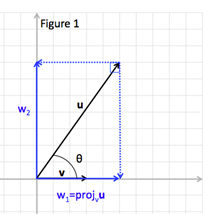Decomposing a Vector into Components
Figure 1 shows vectors u and v with vector u decomposed into orthogonal components w1 and w2.
Vector u can now be written u = w1 + w2, where w1 is parallel to vector v and w1 is perpendicular/orthogonal to w2. The vector component w1 is also called the projection of vector u onto vector v, projv u.

The projv u can be calculated as follows:
PROJECTION OF U ONTO V:
Let u and v be nonzero vectors:
Once the vector component of projv uis found, since u = w1 + w2, component vector w2 can be found by subtracting w1 from u.
w2 = u - w1
Let's look at some examples.
|
Step 1: Find the projv u.
|
|
|
Step 2: Find the orthogonal component. w2 = u - w1 |
w2 = u - w1
|
|
Step 3: Write the vector as the sum of two orthogonal vectors. u = w1 + w2 |
u = w1 + w2
|
|
Step 1: Find the projv u.
|
|
|
Step 2: Find the orthogonal component. w2 = u - w1 |
w2 = u - w1
|
|
Step 3: Write the vector as the sum of two orthogonal vectors. u = w1 + w2 |
u = w1 + w2
|
|
Related Links: Math algebra The First Derivative Rule The Second Derivative Rule Pre Calculus |
To link to this Decomposing a Vector into Components page, copy the following code to your site:
